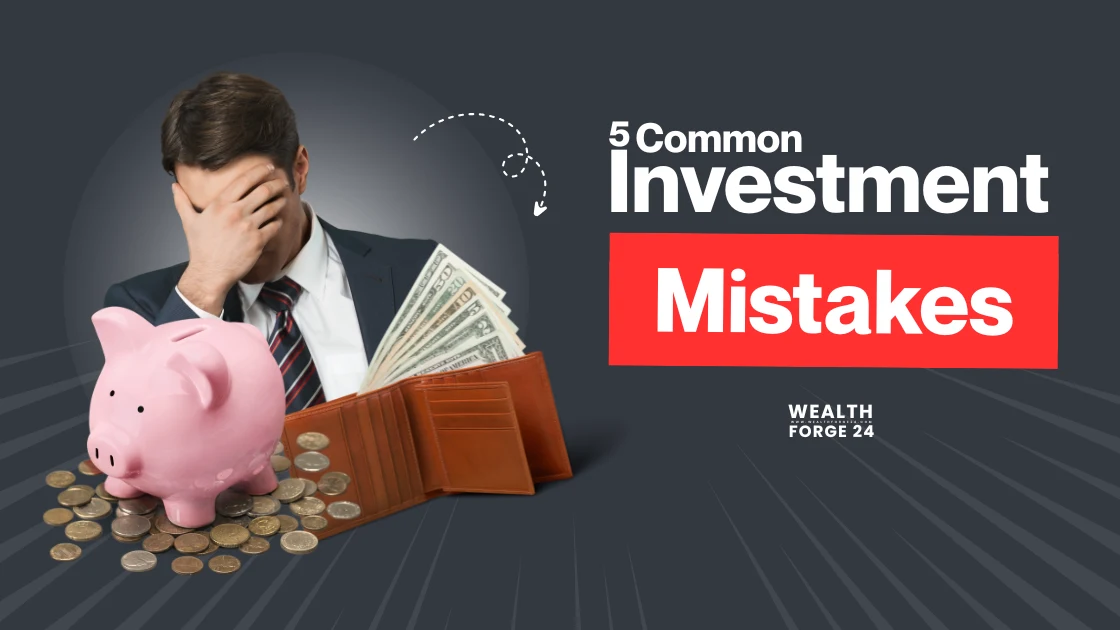Investing can be one of the maximum effective tools for constructing wealth, but it is also easy to make high-priced mistakes—especially whilst you’re just starting. Even skilled traders occasionally fall into not unusual traps which could derail their financial dreams.
The precise news? Most investment errors are avoidable as soon as you recognize what to look for. In this manual, we’ll explore the five maximum common investment errors that cost people heaps of dollars, and more importantly, show you precisely how to keep away from them.
Mistake #1: Starting Too Late (Or Not Starting at All)
The Problem
“I’ll start investing once I have extra money.”
“I’ll wait until I recognize the market better.”
“I’m too young to reflect on retirement.”
These are a number of the most highly-priced sentences in private finance. The largest mistake isn’t creating awful funding—it’s no longer investing in any respect.
Why This is Costly
Time is your finest asset whilst investing, thanks to compound interest. Every year you postpone costs, you incur exponentially greater costs in the end.
Real Example:
- Person A begins investing at age 25: $2/month at 8% return
- Person B begins investing at age 35: $200/month at 8% go back
At age sixty-five:
- Person A has: $622,000
- Person B has: $264,000
Person A invested handiest $24,000 more ($200 × three hundred and sixty five days × 10 years), but ended up with $358,000 more—this is the power of starting early.
The Psychology Behind It
People put off investing due to the fact:
- Perfectionism: Waiting for the “best” time to begin
- Information overload: Feeling beaten by means of alternatives
- Fear of loss: Worried approximately making mistakes
- Instant gratification: Preferring to spend now in preference to save for later
- Underestimating time: Not understanding how fast years pass
How to Fix It
Start now, even supposing small:
- You don’t need lots to start—many brokers can help you begin with $one hundred or less
- Open a brokerage account these days (takes 15 minutes)
- Start with index finances if you’re unsure in which to begin
- Set up automated month-to-month contributions, irrespective of how small
Action Steps:
- Choose a broker: Vanguard, Fidelity, Charles Schwab, or Robinhood
- Open a Roth IRA or a popular brokerage account
- Set up automated transfers of $50-$two hundred in keeping with month
- Invest in a target-date fund or S&P 500 index fund
- Increase contributions as your income grows
Remember: Investing $100/month beginning nowadays is better than planning to make investments $500/month “sooner or later.” Someday hardly ever comes.
Mistake #2: Trying to Time the Market
The Problem
“I’ll look forward to the market dropping before I invest.”
“Stocks are too high proper now, I’ll purchase whilst they’re inexpensive.”
“I’ll promote now and buy lower back whilst it’s decrease.”
Market timing—trying to are expecting while fees will rise or fall—is one of the most seductive and damaging investment errors.
Why This is Costly
Even professionals can’t constantly time the market. Studies show that:
- ninety percent of expert fund managers fail to beat the market over 15 years
- Missing just the 10 excellent days in the marketplace over two decades reduces returns by 50%
- Market recoveries frequently appear all at once and unpredictably
Real Example: From 1992 to 2021 (30 years), the S&P 500 again 10.7% yearly. But:
- If you neglected the 10 best days, Return drops to eight.0%
- If you missed the 20 pleasant days, Return drops to six.Zero%
- If you missed the 30 fine days, Return drops to four.Three%
Missing simply 30 days out of seven,500 buying and selling days reduces returns with the aid of more than half!
The Psychology Behind It
Market timing appeals to our:
- Desire for manipulate: Feeling we will outsmart the marketplace
- Loss aversion: Fear of buying earlier than a crash
- Recency bias: Believing current tendencies will keep
- Confirmation bias: Seeking records that help our timing decisions
- FOMO: Jumping in after huge profits, promoting after losses
How to Fix It
Adopt a consistent investment method:
Dollar-Cost Averaging (DCA): Investing a fixed amount regularly, no matter how the market behaves.
Instead of investing $12,000 once a year, invest $1,000 every month. This:
- Decisions are made without emotion
- Calculates the average price of your purchase
- Utilizes both excessive and occasional markets
- Creates a field
Action Steps:
- Set up automated month-to-month investments
- Commit to your timetable for a minimum of 365 days
- Don’t test your portfolio every day
- Focus on time IN the market, no longer timing the marketplace
- Rebalance simplest once or twice according to 12 months
Key Principle: The satisfactory time to make investments was the day prior to this. The second-best time is these days.
Mistake #3: Not Diversifying Your Portfolio
The Problem
Putting all your money into:
- One inventory (although it is your enterprise’s)
- One region (tech, for instance)
- One asset class (most effective shares, no bonds)
- One geographic vicinity (best U.S. Stocks)
This is the economic equivalent of setting all of your eggs in one basket—after which sporting that basket throughout a tightrope.
Why This is Costly
Lack of diversification exposes you to catastrophic losses if that funding fails.
Historical Examples:
- Enron personnel who had retirement finances heavily invested in Enron stock lost the whole lot when it collapsed
- Tech buyers in 2000 who only owned tech shares lost 78% at some point of the dot-com crash
- Real estate investors in 2008 who had only owned property saw values drop 40-60%
Even super groups can fail: Kodak, Blockbuster, Sears, and others were as soon as market leaders.
The Psychology Behind It
We fail to diversify because of:
- Overconfidence: “I understand this company will prevail.”
- Familiarity bias: Preferring investments we recognise
- Home bias: Favoring home over international investments
- Recent fulfillment: “This stock has executed properly, so I’ll buy more”
- FOMO: Concentrating in hot sectors or belongings
How to Fix It
Build a nicely varied portfolio:
Basic Diversification Framework:
By Asset Class:
- Stocks (increase and earnings)
- Bonds (stability and profits)
- Real property (REITs)
- Cash (emergency buffer)
By Geographic Region:
- U.S. Stocks (60%)
- International advanced markets (25%)
- Emerging markets (15%)
By Sector: Don’t listen to more than 10% in any single sector:
- Technology
- Healthcare
- Financials
- Consumer goods
- Energy
- Industrials
- Real estate
- Utilities
By Company: Never put more than 5% of your portfolio in a unmarried inventory.
Sample Diversified Portfolio for Beginners:
- 60% U.S. Total Stock Market Index Fund
- 20% International Stock Index Fund
- 15% Bond Index Fund
- five % REIT Index Fund
Action Steps:
- Review your current portfolio
- Identify concentrations (> 10% in a single stock/zone)
- Gradually rebalance to lessen awareness
- Consider using total market index funds for immediate diversification
- Rebalance yearly to preserve your goal allocation
Remember: Diversification won’t maximize profits, but it protects you from devastating losses.
Mistake #4: Letting Emotions Drive Your Investment Decisions
The Problem
Emotional, investing looks as if:
- Panic promoting in the course of market crashes
- Buying stocks when they’ve already soared (FOMO)
- Holding losing investments, hoping they’ll recover (loss aversion)
- Constantly checking your portfolio and reacting to everyday actions
- Following hot recommendations from friends or social media
- Abandoning your investment plan during volatility
Why This is Costly
Emotional choices always result in buying high and promoting low—the alternative to a hit is investing.
Research shows:
- The common investor underperforms the S&P 500 via four-five% annually because of emotional timing
- During the 2008 disaster, buyers who neglected the 50% recovery that accompanied
- In 2020, individuals who panicked in March overlooked the quickest recovery in history
Example: The S&P 500 returned 10% annually from 2000-2020, but the common investor earned only five.Nine percent because of terrible timing decisions driven by emotion.
The Psychology Behind It
Fear and Greed: These emotions pressure the most terrible investment selections.
Fear causes:
- Selling after losses
- Avoiding stocks after crashes
- Keeping too much in coins
- Paralysis and a state of no activity
Greed causes:
- Chasing warm shares
- Taking an immoderate chance
- Ignoring fundamentals
- Abandoning diversification
Cognitive Biases:
- Recency bias: Believing recent developments will retain
- Confirmation bias: Seeking records that confirm our ideals
- Anchoring: Fixating on buy rate
- Herd mentality: Following the group
How to Fix It
Create structures that remove emotion from investing:
1. Have a Written Investment Plan Document:
- Your monetary dreams and timeline
- Target asset allocation
- Rebalancing regulations
- When you will promote (if ever)
- Emergency protocols
2. Automate Everything
- Automatic paycheck deductions
- Automatic investments
- Automatic rebalancing
- Remove the need for decisions
3. Limit Portfolio Checking
- Check quarterly, no longer daily
- Disable fee alerts
- Uninstall trading apps from the telephone
- Focus on lengthy-time period overall performance
4. Use Index Funds
- Removes inventory-choosing temptation
- Provides large diversification
- Lower stress and emotional attachment
Five. Have an Emergency Fund
- 3-6 months’ expenses in cash
- Prevents panic selling investments for emergencies
- Provides mental safety
6. Remember Historical Context
- Markets constantly get better sooner or later
- Every crash has been accompanied by the aid of restoration
- Downturns are regular, not catastrophic
- Time heals volatility
Action Steps:
- Write your funding coverage statement these days
- Set up automated contributions
- Commit to checking the portfolio’s best quarterly
- When you experience emotional about markets, wait 48 hours before performing
- Keep a “why I’m investing” awareness to examine during unstable times
Key Principle: Your investment plan has to be boring and mechanical. Excitement in investing commonly costs money.
Mistake #5: Paying Too Much in Fees
The Problem
Ignoring or underestimating funding expenses:
- High rate ratio mutual funds (1-2%)
- Financial guide costs (1-2% annually)
- Frequent buying and selling commissions
- Load costs on the mutual price range
- Account maintenance costs
Many buyers awareness completely on returns and forget about charges, no longer knowing how dramatically prices compound negatively over time.
Why This is Costly
Fees are assured losses that compound against you all the time.
The Devastating Math:
Scenario:
- $one hundred 000 invested for 30 years
- 8% annual go back
With a 0.1% rate (index fund):
- Ending stability: $988,000
- Fees paid: $30,000
With 1% charge (actively controlled fund):
- Ending stability: $743,000
- Fees paid: $275,000
With 2% fee (a few advisors + high-rate finances):
- Ending stability: $550,000
- Fees paid: $482,000
That is more than 1.9% in charges value, you $438,000 over 30 years—almost half your capacity wealth!
The Psychology Behind It
We neglect costs due to the fact that:
- Small number phantasm: 1% doesn’t sound like a lot
- Lack of transparency: Fees are regularly hidden in quality print
- Trust in specialists: Assuming advisors earn their costs
- Complexity: Fee systems are intentionally complicated
- Focus on returns: We are aware of gains/losses but not the slow rate drain
How to Fix It
Minimize investment costs aggressively:
1. Choose Low-Cost Index Funds with Target fee ratios under zero.20%:
- Vanguard Total Stock Market: zero.03%
- Fidelity Total Market Index: 0.1/2%
- Schwab S&P 500 Index: zero.02%
2. Avoid Load Fees. Never pay:
- Front-stop hundreds (expenses to buy)
- Back-stop hundreds (expenses to sell)
- 12b-1 advertising fees
3. Minimize Trading
- Reduce transaction costs
- Avoid tax results
- Embrace purchase-and-maintain
Four. Question Financial Advisor Fees: If the use of an advisor:
- Negotiate fees (1% or much less)
- Consider robo-advisors (zero . 25-zero.50%)
- DIY with index finances (almost unfastened)
Five. Comparison Shop Platform alternatives:
- Vanguard: Lowest-value finances
- Fidelity: Zero-rate index funds
- Schwab: No account minimums
- M1 Finance: Free computerized investing
Fee Checklist:
- Expense ratio < 0.20%
- No load fees
- No account prices
- Minimal buying and selling expenses
- Tax-green fund selection
Action Steps:
- Review your present-day investments’ price ratios
- Calculate the overall expenses you’re paying annually
- Compared to low-price index fund alternatives
- Gradually transition to lower-cost options
- Set a calendar reminder to study fees yearly
Remember: A 1% fee might not sound like an awful lot, but it is the distinction between a snug retirement and working into your 70s.
Bonus Mistake: Not Learning From Your Mistakes
The Meta-Problem
Perhaps the biggest mistake is making the same errors time and again without reflection or adjustment.
How to Fix It:
- Keep a funding journal
- Review decisions quarterly
- Learn from both wins and losses
- Read funding books and resources
- Stay humble and open to new information
Putting It All Together: Your Action Plan
Now that you understand the five largest funding mistakes, right here’s your step-by-step motion plan:
This Week:
- Open a funding account in case you don’t have one (1 hour)
- Set up computerized month-to-month investments (15 minutes)
- Write your funding policy assertion (30 minutes)
- Review current portfolio for diversification (20 mins)
- Check expense ratios on current holdings (15 minutes)
This Month:
- Build a 3-6 month emergency fund
- Transition to the low-price index price range if wished
- Set quarterly portfolio overview reminders
- Educate yourself (read one funding book)
- Celebrate beginning your funding journey!
This Year:
- Stick to your computerized funding plan
- Don’t test the portfolio extra than quarterly
- Ignore market noise and short-term volatility
- Increase contributions while you get increases
- Review and rebalance once in keeping with 12 months
The Bottom Line
Successful investing isn’t always approximately being clever—it’s approximately avoiding silly errors.
The 5 errors we protected:
- Starting too overdue
- Trying to time the market
- Not diversifying
- Letting emotions power selections
- Paying an excessive amount of expenses
…Account for the large majority of investment underperformance.
The properly news? All 5 are completely avoidable. You do not need to be a monetary genius, expect the destiny, or have insider information. You need to:
- Start now
- Invest always
- Diversify extensively
- Stay disciplined
- Minimize prices
Do those five things, and you’ll outperform maximum professional traders over the long term.
Your wealth isn’t determined by what you earn—it is determined by what you hold and the way you invest it.
Take Action Today
Don’t let this text be some other piece of statistics you read and neglect. Take movement now:
If you have not commenced investing, open an account these days
If you‘re seeking to time the marketplace, set up computerized investments
If you lack diversification, spend money on a total marketplace index fund
If you’re emotional approximately markets, write your funding policy assertion
If you’re paying high fees, study low-value options
The pleasant investment you may make is in your financial education and conduct. Start today.
Disclaimer
This article is for academic functions and does not constitute financial advice. Investment decisions ought to be based on your person circumstances, dreams, and risk tolerance. All investments carry risk, which includes capacity lack of primary capacity. Past overall performance does not assure destiny consequences.
Before making funding selections, conduct thorough research and don’t forget to consult with a certified financial advisor. The examples and eventualities supplied are hypothetical and for illustrative purposes simplest.
For greater facts, please study our full Disclaimer.
Ready to analyze more approximately investing? Check out these associated articles:
- What is Investment? A Beginner’s Guide
- How Do You Invest in Cryptocurrency?
- What Are Stock Fundamentals?
Have questions about fending off investment mistakes? Contact us – we are right here to help!








